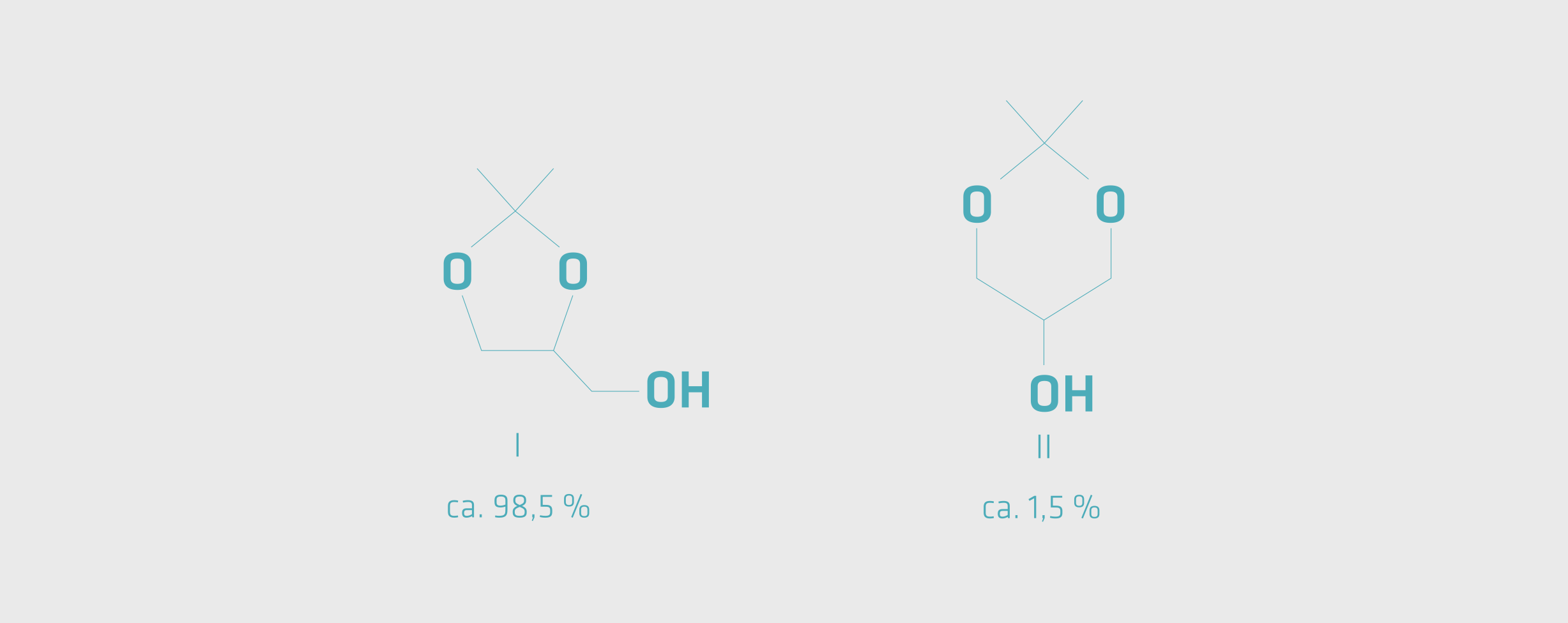
Glaconchemie
GLYCASOL
2,3-O-ISOPROPYLIDENGLYCERIN
GYCASOL® and its application
2,3-O-Isopropylidene glycerine I is a monovalent, primary alcohol, which may be formally described as methanol substituted by a cyclic ether group.
Owing to these two chemical groups of different polarity the molecule shows high affinity to polar as well as to less polar or even up to non-polar substances. As an outstanding property in this sense the complete miscibility with water may be mentioned. At the same time isopropylidene glycerine is miscible with nearly all other groups of organic substances. For these reasons it is especially qualified for the use as solvent for very miscellaneous applications.
The most important industrial applications will be found in colours and varnishes, printing inks, adhesives, pesticides, detergents and cleaning agents or metal cleaners, emulsifiers and dispersants or extracting agents. But beside its function as a plain solvent isopropylidene glycerine can exhibit discrete lacquer-forming properties like retardation of drying or film formation. Isopropylidene glycerine is being appreciated for years by cosmeticians as ingredient in personal care products, perfumes and essences. The alcoholic hydroxyl functionality of the molecule allows for the participation as building block in many reactions. Within condensation reactions causing the release of water isopropylidene glycerine is being incorporated into polyesters, polyurethanes, polyacrylates, polyethers et cetera, in order to modify their properties. The reaction with anhydrides and acids will yield esters. Results of our lab experiments addressing the characterisation of this substance are available on request.

GLACONCHEMIE will produce GLYCASOL® / Isopropylidene glycerine exclusively from biogenous glycerine originated from vegetable oils. The proportion of biogenous material in the finished product GLYCASOL® will be 68.2 %.
Toxicity and safety
According to GHS we have classified Isopropylidene glycerine with the code H319, category 2, and label our samples with the pictogram GHS07 and the signal word “warning”. For additional information on the safe handling and the toxicity of the product, consult the Material Safety Data Sheet.
Technical Information GLYCASOL® / 2,3-O-ISOPROPYLIDEN GLYCERINE
SYNONYMS
I 2,2-Dimethyl-1,3-dioxolane-4-methanol (4-Hydroxymethyl-2,2-dimethyl-1,3-dioxolane) [approx. 98,5 %]
II 2,2-Dimethyl-1,3-dioxane-5-ol [approx.1,5 %]
(mixture of isomers)
At room temperature isopropylidene glycerine (also referred to as Solketal) is a clear, colourless, practically odourless, mobile liquid. As a by-product of the main component 2,3-O-isopropylidene glycerine the structural isomer II is present in very small amounts:
STRUCTURAL FORMULA C6H12O3

TYPICAL PROPERTIES
Colour
colourless
Isopropylidene glycerine
wt% 98,5
Glycerine
wt% 1,0
Water
wt%< 0,5
pH-value (20 °C)
7,2
Viscosity (25 °C)
mPa.s 11
PHYSICAL PROPERTIES
Molecular weight
132,16
Boiling range
188-191°C
Vapour pressure (20 °C)mbar
< 0,25
Flash point
80°C
Density (20 °C)
1,066g/cm³
Refractive index (20 °C)
1,4309
Conductivity(20-100 °C) µS/cm
~ 1,02
Surface tension(25 °C) mN/m
32,10
Hydroxyl value (OH-value)
403
Hydroxyl value (calculated)
424
REGULATORY INFORMATION
CAS
100-79-8
EINECS
202-888-7
INCI Name
Isopropylideneglycerol
REACH
registriert unter EC / List-No. 202-888-7
ATTENTION
All information contained in this document is based on our best knowledge for the time being, but no guarantee, warranty or representation is made, intended or implied as to the correctness or sufficiency of any information.